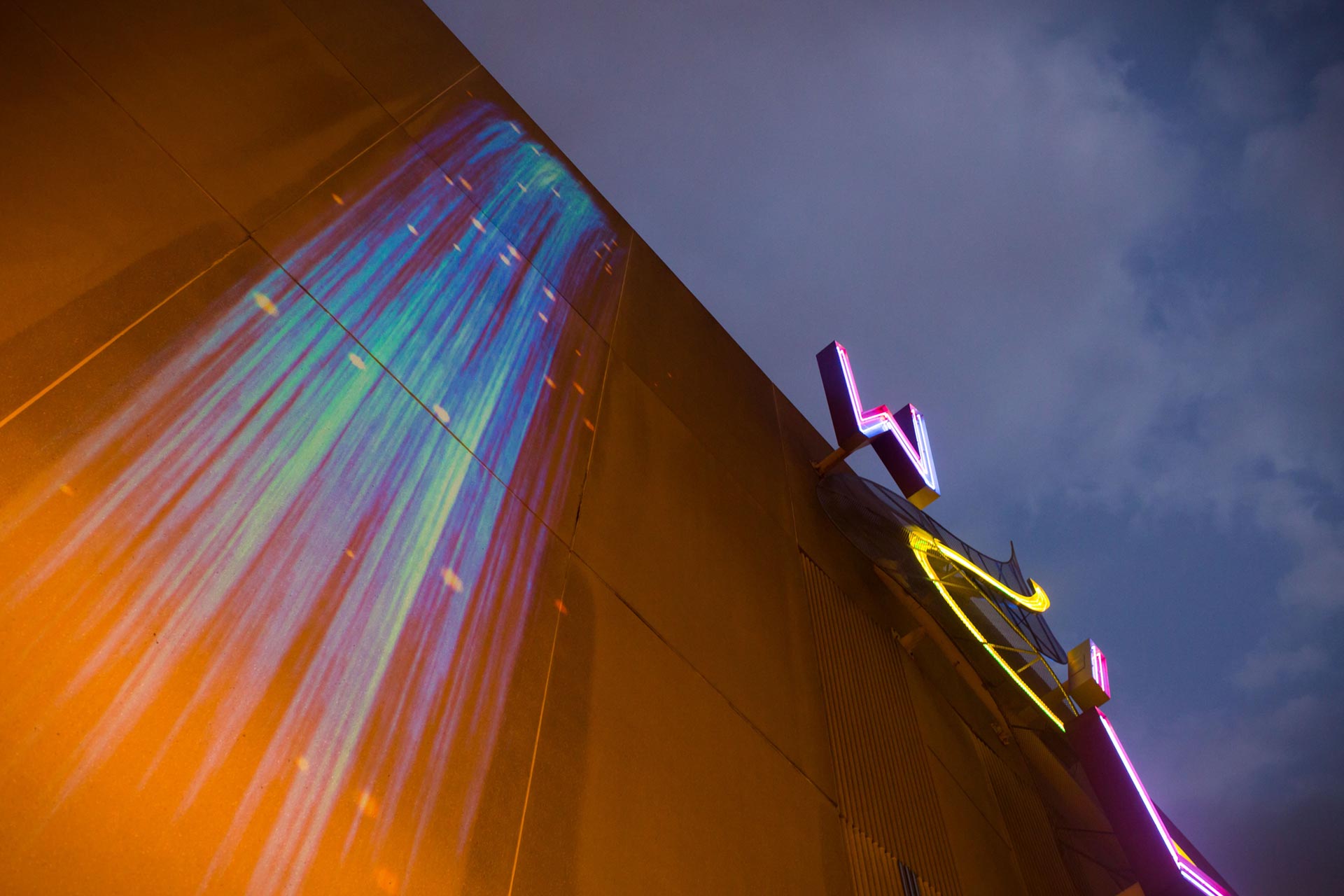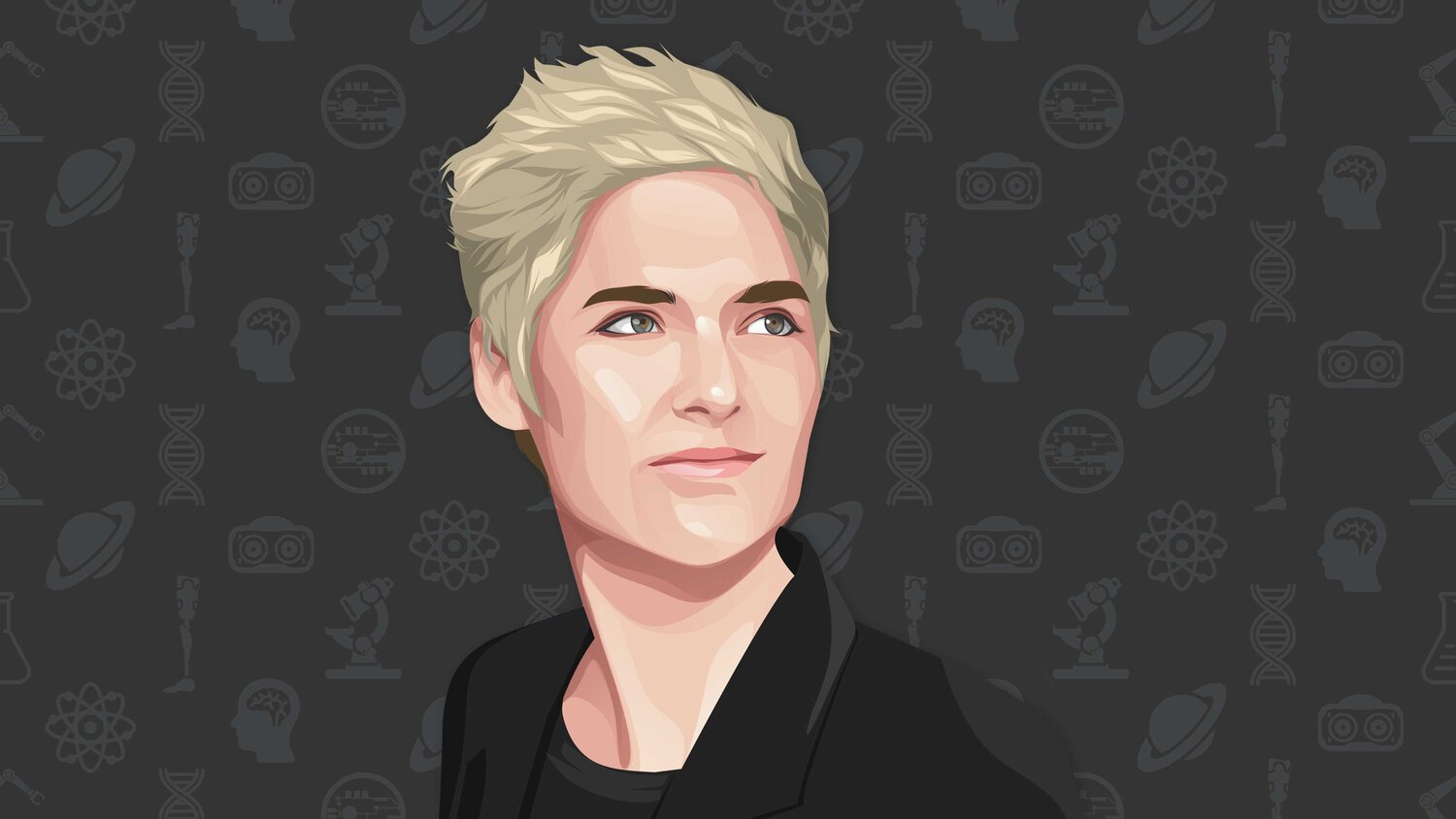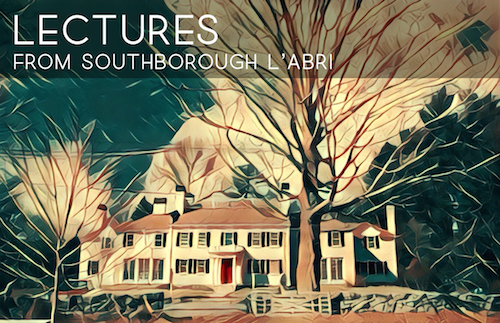Risk
Poetry works by contradictions, qualifications by metaphor, wherein there are overlappings, discrepancies, and contradictions. Paradox is related to irony and to figurative language.

It’s a Question of Risk: Art, Science and Climate Collaboration Strategies

Andrea Polli
Professor, Mesa Del Sol Endowed Chair in Digital Media
Andrea Polli is currently a Professor and Director of STEAM NM with appointments in the College of Fine Arts and School of Engineering at the University of New Mexico. She holds the Mesa Del Sol Endowed Chair of Digital Media and directs the Social Media Workgroup, a lab at the University’s Center for Advanced Research Computing.
Reflection
“A model is only a caricature or a cartoon of reality, and it will never match reality, and it actually wouldn’t make sense to match reality. Then we don’t need a model, we can as well study it directly…”
— Dr. Andreas Fischlin, Zurich, Coordinating lead author of the IPCC, co-recipient of the 2007 Nobel Peace Prize
Despite their detail, by design contemporary climate models are nowhere near as detailed or complex as the systems they represent; however, they are essential to the scientific understanding of climate. In an interview with the author, ETH climate scientist, IPCC coordinating author, and Nobel Prize winner Andreas Fischlin explained: “A model is only a caricature or a cartoon of reality, and it will never match reality, and it actually wouldn’t make sense to match reality, then we don’t need a model, we can as well study it directly. Sometimes that is actually a pitfall, people build models that are too complex and then have to struggle with them. In that case it would be better to do fieldwork, but you see we need to use models to see what future impacts could have on our environment” (Fischlin 2007). (p. 177)
Järvinen believed that the artists’ works were not subject to the same rigor as that of scientists. Unlike the scientists in Antarctica, who celebrated the artists’ freedom as providing a potential outlet for ideas the scientists themselves did not have the freedom to express, as discussed in the chapter ‘Ground Truth’, Järvinen was concerned about potential conflicts between art and science. As he stated: “Artists are allowed more freedom, and it doesn’t matter if they go wrong. But if a scientist goes wrong, it does matter. And he may be ridiculed or lose a job if he gets very deeply involved in such programs which are not very clearly cited” (Järvinen 2010). (p. 205)
Like Järvinen, Kainz extended his ideas about the scientific process to his philosophies of knowledge. He said: “The creation of knowledge means that human beings have the opportunity to work on themselves, to develop themselves, and to perhaps be able to tackle certain problems because they have been agonizing over problems. And the moment you agonize over a problem, you change your brain” (Kainz 2010). In this way he was identifying the creation of knowledge as a kind of ecosystem stressor, or a factor that creates a physiological change. He stressed that the way one most effectively agonizes over a problem is through collaboration, and he extended this collaboration to interdisciplinary work. As he stated: “We need to listen to each other. If we listen to each other carefully, then it will change us as well. That’s the wonderful trade of the human being. If we think that we need to solve a problem in arts or in science, or in economy, then we can do that” (Kainz 2010). In this statement Kainz emphasised the transformative potential of interdisciplinary collaboration not only to solve problems but also to change the people involved in the collaboration. (p. 207-208)
“There is more information available at our fingertips during a walk in the woods than in any computer system.” — Mark Weiser
Addressing the topic of information overload back in 1991, Mark Weiser wrote: “There is more information available at our fingertips during a walk in the woods than in any computer system, yet people find a walk among trees relaxing and computers frustrating. Machines that fit the human environment, instead of forcing humans to enter theirs, will make using a computer as refreshing as taking a walk in the woods.”

“In addition to showing some of the ways that computers can find their way invisibly into people's lives, this speculation points up some of the social issues that embodied virtuality will engender. Perhaps key among them is privacy: hundreds of computers in every room, all capable of sensing people near them and linked by high-speed networks, have the potential to make totalitarianism up to now seem like sheerest anarchy. Just as a workstation on a local-area network can be programmed to intercept messages meant for others, a single rogue tab in a room could potentially record everything that happened there.”
“Even today, although active badges and self-writing appointment diaries offer all kinds of convenience, in the wrong hands their information could be stifling. Not only corporate superiors or underlings, but overzealous government officials and even marketing firms could make unpleasant use of the same information that makes invisible computers so convenient.”
“The important waves of technological change are those that fundamentally alter the place of technology in our lives. What matters is not technology itself, but its relationship to us.”
“How can you design technology that becomes a part of a user’s life and not a distraction from it? This practical book explores the concept of calm technology, a method for smoothly capturing a user’s attention only when necessary, while calmly remaining in the background most of the time. You’ll learn how to design products that work well, launch well, are easy to support, easy to use, and remain unobtrusive.”
“The scarce resource of the 21st century will not be technology; it will be attention.” — Mark Weiser

The Calm Before the Storm
He replied, “When evening comes, you say, ‘It will be fair weather, for the sky is red,’ and in the morning, ‘Today it will be stormy, for the sky is red and overcast.’ You know how to interpret the appearance of the sky, but you cannot interpret the signs of the times.
Ubiquitous computing promised a calm that it was not able to deliver, because of problems with the business and governance models that Mark Weiser regarded as potentially “unpleasant.” When private data becomes the private property of a corporate entity, and commoditized as a model for behaviour prediction that is able to dominate and monopolize public discourse, the conditions become favourable for a climate of totalitarianism.
Storming the Capitol was the actual result of ubiquitous computing weaponized by a reality television celebrity. Private personal data has now become a feedback loop that is amplifying the storytelling capacities of human beings to manufacture belief systems through the repetition of propaganda and conspiracy theories. Proprietary algorithms are amplifying the story of scarcity, capital, property, and domination, creating a storm of cognitive disturbances driven by differences in the temperature of a nation state’s political outrage.
Mental models of human experience are limited tools for making sense of reality.
As human beings, these are the tools that we have available to us: perception, cognition, emotion, and action. Memories—the stories of past experiences—are the filter through which we perceive the present. Measurable patterns of experience are the data that have been collected through experiments of trial and error. These are the patterns that we extrapolate into the future to imagine, design, and build new possibilities based on past experiences.
“Now there is one outstandingly important fact regarding Spaceship Earth, and that is that no instruction book came with it. I think it’s very significant that there is no instruction book for successfully operating our ship. In view of the attention to all other details displayed by our ship, it must be taken as deliberate and purposeful that an instruction book was omitted.… So, we were forced, because of a lack of an instruction book, to use our intellect, which is our supreme faculty, to devise scientific procedures, and to interpret effectively the significance of the experimental findings. Thus, because the instruction manual was missing we are learning how we safely can anticipate the consequences of an increasing number of alternative ways of extending our satisfactory survival and growth—both physical and metaphysical.” (R. Buckminster Fuller, Operating Manual for Spaceship Earth, p.60)
Andrea Polli’s Approach
“When I thought about this talk, I thought about six strategies that have been useful to me and that I’ve seen other artists and designers use in relation to art, science, and climate change. These are:”
- Imagine Consequences
- Promote Public Engagement
- “Community” Science (as opposed to citizen science)
- Collaborate in the Laboratory and Field
- Encourage Open Data
- Create Collaborations within and between Institutions and Communities
Design for resilience begins with the thought that things will go wrong, integrating an awareness of the unintended consequences of design. Imagining consequences is at the core of reimagining our social architecture.
Carlotta Aoun asked, “Is it possible to create art with sustainable and degradable materials that creates as much impact and attention as technology pieces can?”
I went in search of Mark Weiser’s quote to discover the context of what he was discussing was information overload.
“There is more information available at our fingertips during a walk in the woods than in any computer system, yet people find a walk among trees relaxing and computers frustrating. Machines that fit the human environment, instead of forcing humans to enter theirs, will make using a computer as refreshing as taking a walk in the woods.”
Our machines, our inventions, and our technologies have become the feedback loop of our own intentions to outsource our work to ease our requirements for labour. Humans have become the environment for the machines, refreshing their requirements for energy through human labour. The machine’s requirements for energy have become the driving motivation for human labour. The engine for the machine is human exploitation as encoded into the inventions of property law, capital, corporations, nation states, compound interest, and debt slavery.
“Humans that fit the machine environment, instead of forcing machines to enter theirs, will make using humans as simple as refreshing the lithium-ion batteries.”
The art of being human is in our ability to reconnect to the organic living systems that sustain our lives.
“And let us consider how we may spur one another on toward love and good deeds, not giving up meeting together, as some are in the habit of doing, but encouraging one another—and all the more as you see the Day approaching.”
Inhumanity arises from the feeling of entitlement that is afforded by the digital divide, the expectation that our tools and technologies will save us from our dependence on our tools and technologies.
Ephemeralization is the invisible nature of the work of caring, that does not factor into the calculations of GDP.
Metaphysical gravity creates a coherence of action that produces a fusion of individuals into more complex relationships, releasing energy in the form of empathy, compassion, kindness, collaboration, and love.
The interplay of opposites, the positive and negative forces in nuclear fusion, create radiation of energy through the compression of gravity.
The conservative Christian theological discussion presented by Sarah Chestnut at L’Abri Fellowship Southborough explored the centrality of paradox.
A community of deconstructing Christian Evangelicals, atheists, and Buddhists were exploring the concept of shame.
The spiritual but not religious anarchists were exploring the spectrum between victimhood and entitlement.
Notes
- Paradox
- Opposites
- Polarization
- Metaphor
- Weather
- Signs of the times
- Storm the Capitol
- Climate Change
- Acts of God
- Nathalie Miebach
- Andrea Polli
- In polite society, it is impolite to speak of religion, money, or politics
- When talking about the weather is politicized, there is nothing left to talk about in polite society
A Canadian Persona
If I were to create a persona of Canada, Justin Trudeau would be the face of neo-colonial white supremacist capitalist patriarchy. His blackface photo would be the image of Canadian duplicity.
The personality sliders that are often part of the typical design deliverable might include the following scales, showing the spectrum leaning far to the right of each continuum.
- Shame - Entitlement
- Truth - Cowardice
- Honesty - Complicity
- Responsibility - Victimhood
- Perseverance - Learned Helplessness
- Resolve - Bureaucratic Intransigence
- Courage - Politeness
- Commitment - Isolation
- Reconciliation - Hoarding
- Self-Awareness - Genocide
The Storm Was Foreseeable
Stacey Plaskett, congresswoman and Impeachment Manager, was part of the team that sought the conviction of Trump for inciting an insurrection and the violent storming of the Capitol.
Clearly, in this case, the storm was foreseeable. It was a man-made change in the climate of a nation, intended to inflame the same hatred and violence that resulted in a civil war from 1861 to 1865. As Plaskett stated, that war did not resolve the core grievance that sparked the violence. Justice was not delivered. The perpetrators of injustice and the leaders of the rebellion walked free, as they did on February 13, 2021.

The Importance of Paradox: Poetry, Prayer, & the Life of Simon Peter
By Sarah Chestnut
It's appropriate, I think, to extend this metaphor of the language of paradox, and turn to a literary dictionary for a definition. Mine defines paradox as the language appropriate and inevitable to poetry. Poetry works by contradictions, qualifications by metaphor, wherein there are overlappings, discrepancies, and contradictions. Paradox is related to irony and to figurative language.
The poet Christian Wyman notes that he turns to poetry to think through existential questions, because poetry does not think through so much as undergo such questions. And I've been puzzling on that for quite some time. And I think though, that this is what it means that poetry works by overlappings, discrepancies contradictions, this is the nature of metaphor to describe one thing in terms of another when it does not seem to be like that thing in any obvious way and to discover just how right and illuminative that comparison is. That is the work of metaphor.
Often, the discovery of the likeness is made after the metaphor is made. The metaphor leads the thinking rather than the thinking leading the metaphor.

Models and Metaphors
Because of our perceptual and cognitive limitations, human beings are unable to know in full. We can only know in part. We seek to understand, but ultimately, we require humility to recognize that we cannot possibly know everything. We must rely in the incomplete data and imprecise models to understand.
In using models and metaphors, we risk using imprecise representations and language to approximate a more complete understanding of reality. However, our understanding is little more than an image or a map that helps us to remember an experience or orient us to time and place in reality. It can never really be the reality itself. For humans, given our constantly changing perspective, through this moment, this present awareness, reality is ephemeral. We must remember that a static object or image can never really capture the dynamic, evolutionary nature of a reality that is always in motion, always in process.
The physical is a metaphor for the metaphysical.




